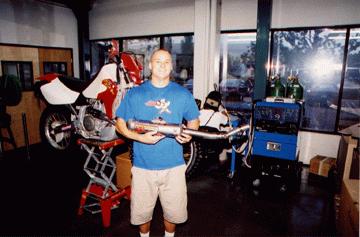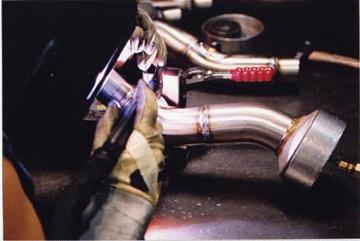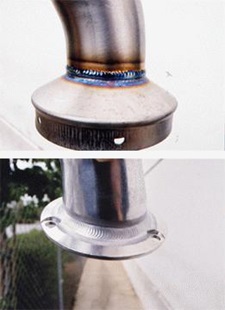Pro Circuit has quickly covered a lot of ground, won many races and attracted countless devotees since it was founded in 1978 by then 18-year-old Mitch Payton, onetime desert-racing pro and motor-tuning specialist. In its early years, Pro Circuit's customers were mostly Husqvarna-mounted desert racers and motocrossers who wanted Payton to provide them with the same speed setups that he and his father had learned to perfect on Payton's personal race machines.
It didn't take long for word to spread around southern California racetracks about Payton's successful motor-building skills and soon Pro Circuit had developed near cult-like status. Payton closed his family's Husqvarna dealership in 1980 to focus all his energies on building Pro Circuit's aftermarket service business.
Twenty-five years later, Pro Circuit has earned an enviable record for its motocross racing team and high-performance parts production. Every weekend, before thousands of hardcore fans at both the AMA/EA Sports Supercross Series and AMA/Chevy Trucks National Motocross Championships, Pro Circuit puts its name on the line and its products to the ultimate test, and the results have been spectacular: 13 American Motorcyclist Association (AMA) Pro Racing 125cc Number One Plates and more than 20 AMA national championships in 11 years.
Pro Circuit's 30,000-sq.-ft. facility houses millions of dollars of performance measurement equipment used by its world-class technicians, mechanics and machinists to provide suspension and engine modifications, hard parts and technical support that give its customers the kind of performance edge that gets results.
 |
Colin Yates of Pro Circuit holds a finished Pro Circuit Titanium 4-Stroke Racing System. Yates is the companys production and welding supervisor.
|
Muffler Boosts Horsepower
For example, not long ago Pro Circuit fabricated an exhaust system that resulted in a significant boost in horsepower. "It was for an '03 Yamaha YZ 450 four-stroke, and I think it was actually our biggest horsepower gain that I've ever seen," says Colin Yates, Pro Circuit's production and welding supervisor. "It had 48-horsepower stock and we brought it up to 52.5, which is a huge horsepower gain.
We also took the '03 Honda CRF 450, which is the same classification as Yamaha's bike, and our muffler boosted it from about 47 or 48 up to 50 horsepower."
And exactly how does a different muffler increase horsepower"
Without giving away any trade secrets, Yates points out, "Let's say you start out with a 1-1-4-in. head pipe and it goes into a 1-1-2-in. piece of tubing. Well, we might change that 1-1-2-in. piece of tubing to 1-3-4-in. or else we might change the perforated core diameter. There are a million different things we can do to this thing to make different power … You can put a megaphone on there. That can sometimes make a difference, too, because it slowly tapers out to 'big' and then it tapers back down to 'small.' So, different lengths in the 'cans,' different overall exhaust lengths, all those factors come into play.
"When we finish a new muffler, we want it to offer a significant performance difference," Yates explains. "You don't want a guy to spend $500 on your pipe and have him say, 'It feels like stock work,' because then he's going to be saying, 'Why did I spend this money' That was a big waste.'"
Yates says the Syncrowave is invaluable because of its steady DC and AC arc throughout its entire output range. Pro Circuit uses the DC output for welding stainless steel and titanium (the Pro Circuit "Ti-4 Titanium 4-Stroke Racing System" is a hot seller right now) and AC squarewave output with adjustable balance control for welding aluminum.
 |
A Pro Circuit operator TIG welds on exhaust system with Dynasty 200. The Dynasty 200s low draw saved Pro Circuit the cost of adding more power at its facility.
|
Pro Circuit also has a Maxstar 200DX and Dynasty 300DX that work in tandem with automated welding systems to boost productivity and help Pro Circuit try to keep pace with demand. The Maxstar and Dynasty feature built-in automation interface connections that make it easier to integrate into an automated system.
Seam Welder Automated
The Maxstar 200DX® is hooked up to a Jetline seam welder that can weld tubes, cylinders and cones made from titanium. "We make our mufflers out of aluminum or titanium - it all depends on how much money our customers want to spend," Yates says. "Our titanium tubing comes out of a big, flat sheet. We cut it up, bend it on our Jammes roller and then put it on the Jetline seamer where we weld the seam and then that's the can" (the can is the main body of the muffler).
Pro Circuit likes the Jetline seam welder because of its reputation for precision: Special gauges ensure the alignment of the weld joint and custom-designed chill bars control penetration and minimize distortion. "This system does an awesome job," Yates says. "After we weld the can, I put it back on the roller and it comes out perfectly round. And that's what you're looking for: you don't want an oval piece when you're selling somebody a round can."
The Dynasty 300DX is hooked up to a rotational welding system made by Contour Arc, which integrated the automated welding systems for Pro Circuit. "The Dynasty 300 works well with this system," Yates says.
"The advanced squarewave on the Dynasty enables us to maintain a sharp point on the tungsten. The arc doesn't wander around on you, so it gives you the capability to get a more precise weld. To get quality like that, you need an inverter type machine".
The Dynasty's advanced squarewave technology differs from the Syncrowave's standard squarewave technology. With the Dynasty, users can adjust output frequency from 20 to 250 Hz and electrode negative (EN) duration from 30 to 90 percent. By fine-tuning these variables, operators can stabilize the arc, reduce arc wandering, obtain excellent directional control over the arc and puddle, establish the weld puddle faster, precisely place the filler and control bead width. In effect, operators can make the weld bead only as wide as it needs to be.
Emphasis on Quality
The automated welding systems have been a lifesaver for Pro Circuit. Initially, welds were done by hand, but as demand increased for the custom mufflers, operators couldn't weld quickly enough. Mass production combined with quality was the answer, and that's when the automated systems came on board.
Pro Circuit emphasizes quality everywhere in the shop. "What we strive to do is to make the best possible product out there," Yates explains. "Other companies want to put out a lot of product and build it fast and make it cheap. We'd rather spend a lot of time on making really good products."
"It's really very simple. From our customers' perspective, when you're spending a couple hundred bucks more for a muffler, you want a couple hundred dollars more worth of quality. The pipes have to fit perfectly on the bikes and meet our customers' expectations for performance, every time. If we do that, our customers are happy and that's the most important thing to us," Yates says.
Pro Circuit has been highly successful at keeping its customers happy, as evidenced by its recent plans to significantly expand operations. However, those plans ran into an early snag that threatened to greatly increase the firm's costs in growing the business. Fortunately, another Miller product came to the rescue.
Low Power Draw
Randy Fleisher, Pro Circuit's production manager, explains that the four-stroke department has been taking in more and more business and reached the point where more welding machines had to be added. "But we couldn't put in any more Syncrowave 250®s because we didn't have any more power left on the primary line. We needed to add three more TIG machines to the production line, but were faced with paying up to $50,000 to put in more power.
"Then Rick Bengard, our sales representative at Five Star Gas and Gear, recommended a solution. He suggested we go with the Dynasty 200® because it draws about half the amperage a Syncrowave does to produce the same output."
"With the low draw of the three Dynasty inverters, our 40-amp/230-V breakers will work withoutmodifications to the primary line," Fleisher says.
Yates adds, "Inverters cost a little more initially, but we save in the long run. We're working for almost 60 hours a week. If you have the chance to save your company half the amount of its electrical bill, who wouldn't want to save that much money?"
Dynasty Saves Space
"And the other cool thing about the Dynasty 200," Yates adds, "is that it's such a small machine. The thing takes up about half the amount of space."
The Dynasty 200 DX weighs 47 lbs. and has a welding range of 1 to 200 amps. It features Auto-Line technology, Wind Tunnel Technology, Fan-On-Demand, Lift-Arc TIG starts, a built-in high-frequency TIG arc starter (no need to purchase an add-on HF unit), controls for true pulsing (peak current, background current, pulse width and pulses per second), sequence controls (initial slope, final slope, initial current and final current) and trigger functions such as trigger hold, spot timer and 4T.
Yates is impressed with the Dynasty inverter's performance. "Working on aluminum with the Dynasty is just unbelievable," he says. "And the heat control, the way you can weld super thin or thick aluminum is amazing. Normally, your weld puddle starts to really grow when you want to weld a thick part to try to get that heat in there. The Dynasty still seems to make super small welds on these really thick parts. It just puts the heat right in the part without spreading the puddle really wide."
The bottom line? "The Dynasty helps Pro Circuit produce a quality product," Yates says. "We don't believe in cutting corners on anything."
 |
A Miller Dynasty 300 DX was used to create the automated weld bead (top) and the manual weld bead (bottom).
|